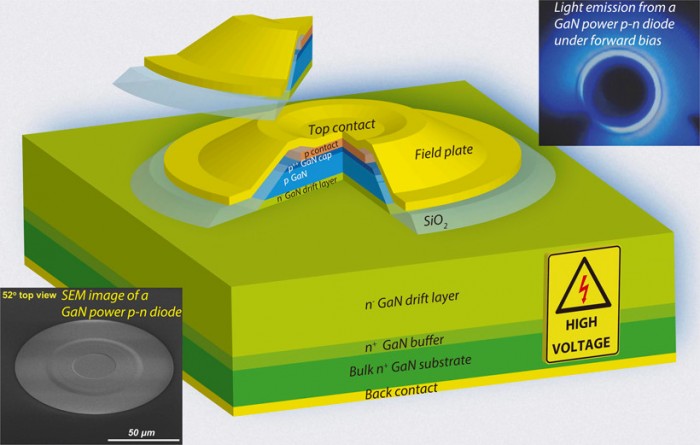Folks,
Years ago, when I was a grad student at Cornell, a scientist gave a talk in which he stated that we entered the “Silicon Age” in 1968. He reminded us that humans advanced through the Stone Age, the Bronze Age and then the Iron (Steel) Age. He claimed we entered the Silicon Age in 1968, because that was the first year that there were more technical papers written on silicon than on steel.
A few weeks ago, I visited Cornell with my Indium Corporation colleague Dr. Robert Ploessl to become familiar with the work of Professor Grace Xing. Professor Xing and her colleagues have developed a power diode using GaN (gallium-nitride) that can support over 1400 volts across a width one tenth of a human hair. See the figure below. When perfected, this technology may enable electrical power distribution stations to be dramatically reduced in size. This size reduction could have a profoundly positive impact on our electrical grid system.

A schematic of the GaN power diode developed by Professor Xing and her colleagues. Image source: https://www.engineering.cornell.edu/engineering2/customcf/iws_news/uploads/apl-hu-gan-resized.jpg
I also had time to briefly visit Professor Dick Shealy. Professor Shealy is researching techniques to make GaN an even more efficient material for LED lighting than it is today. To me, LED lighting has a practical application in that I am changing many of the lights in my house to LEDs. New LEDs now have a pleasant color temperature and only use about 1/7th of the electrical power of a standard incandescent light. As an added benefit, they can last up to 50,000 hours.
In our meeting, Shealy pointed out that so many LEDs are being manufactured that, when the lightng market is fully penetrated by LEDs, there will likely be more GaN wafers produced than silicon wafers.
Considering this, will we soon be in the gallium-nitride age?
Cheers,
Dr. Ron


